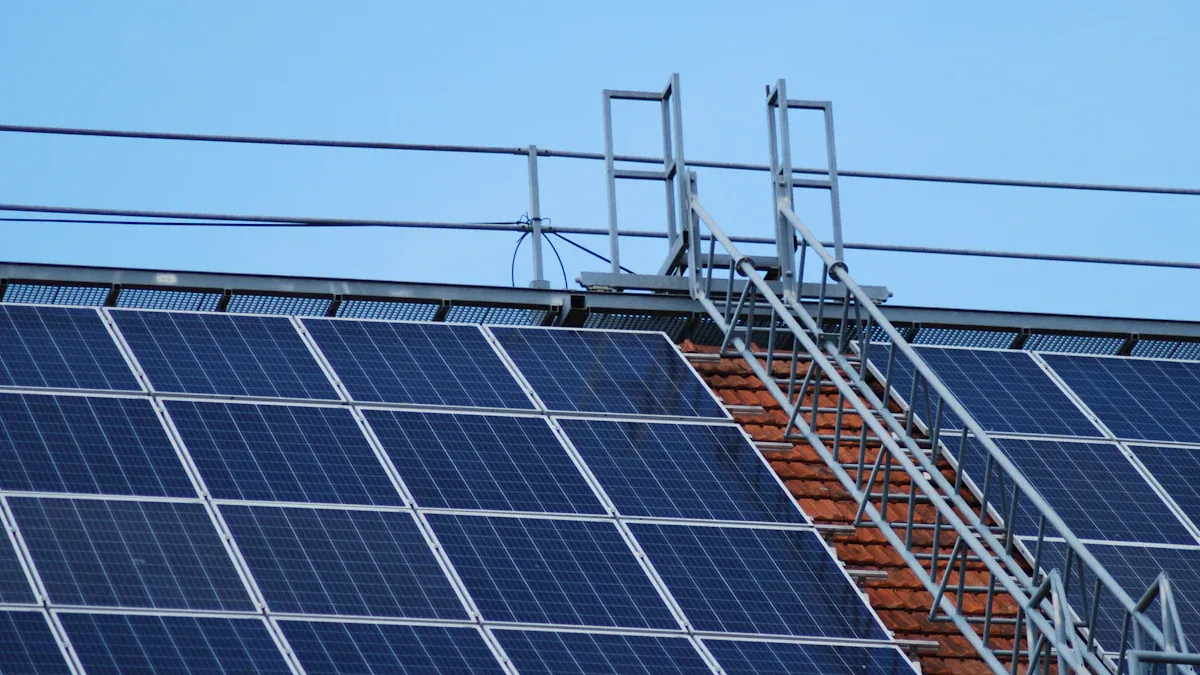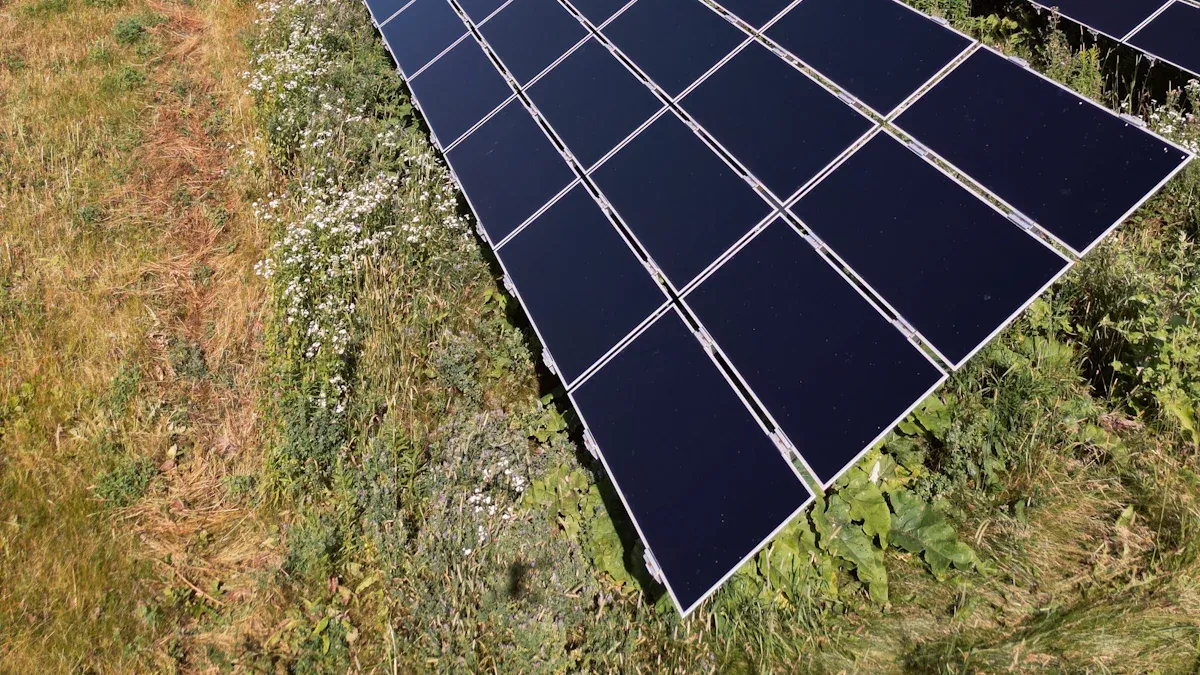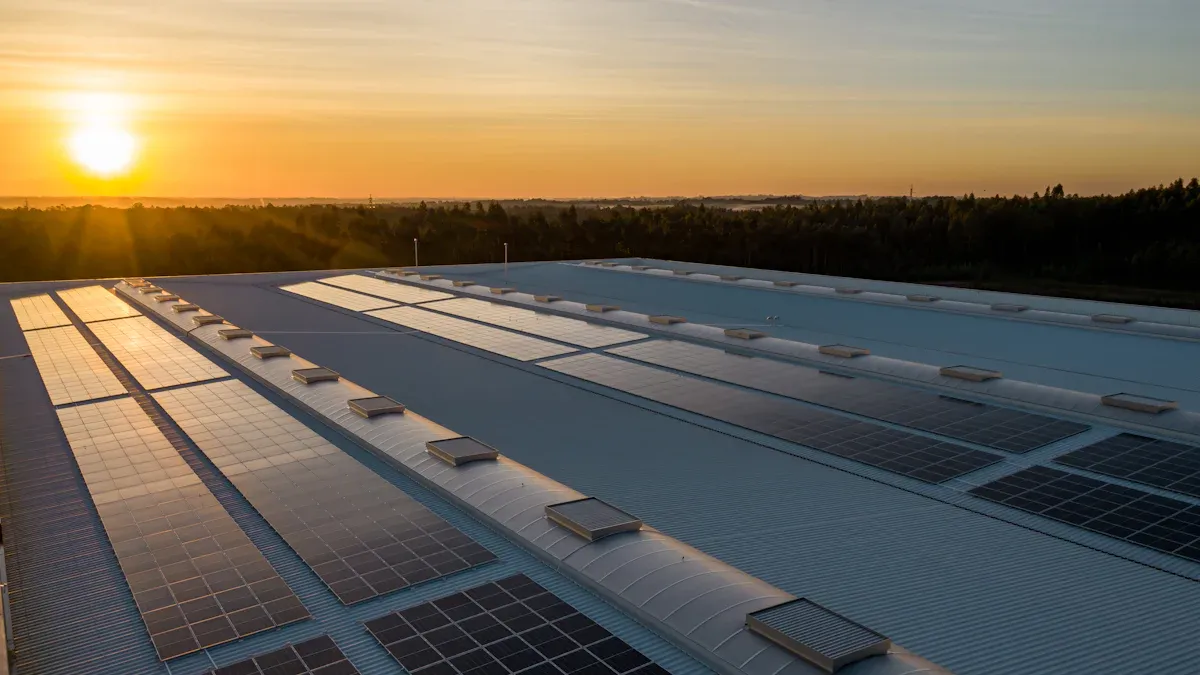Why Steel Structure for PV Panel is the Optimal Solution for Photovoltaic+ Composite Projects

You gain a significant advantage in solar energy projects when you choose a steel structure for pv panel installations. Steel structures for pv panels deliver unmatched strength, long lifespan, and adaptability, making them ideal for any photovoltaic system. With options like galvanized steel, you benefit from corrosion resistance even in coastal or harsh environments. Steel structure for pv panel supports heavy pv loads and adapts to rooftop, ground, or floating setups. This flexibility and adaptability ensure compatibility with different panel types and meet the diverse needs of modern photovoltaic projects.
Key Takeaways
Steel structures provide strong and durable support for PV panels, ensuring long-lasting performance even in harsh weather.
Corrosion-resistant coatings like hot-dip galvanizing protect steel from rust, making it ideal for coastal and industrial environments.
Steel frames adapt easily to rooftop, ground, and tracking systems, offering flexibility for various solar project types and sizes.
Though steel may cost more initially, its low maintenance and long lifespan save money over time and improve system reliability.
Steel is highly recyclable, supporting sustainability and reducing environmental impact in solar energy projects.
Steel Structure for PV Panel

Material Strength and Durability
When you select a steel structure for pv panel installations, you ensure your photovoltaic system stands on a foundation of exceptional strength. Steel structures for pv panels offer a superior strength-to-weight ratio, which means you get maximum support without unnecessary bulk. This quality allows your system to handle heavy loads, such as large arrays or snow accumulation, and withstand harsh weather conditions.
Hot-dip galvanized steel and cold-formed steel both play important roles in solar panel mounting structures. Hot-dip galvanized steel features a thick zinc coating that shields the steel from corrosion and environmental damage. This process creates a uniform layer, usually between 50 and 80 microns, which gives your structure a self-healing property if the surface gets scratched. Cold-formed steel, on the other hand, is lightweight and easy to fabricate, making it ideal for rooftop and carport systems. Both types meet the tensile and yield strength requirements needed to support pv panels for more than 20 years.
By choosing the right steel structure, you maximize the material strength and durability of your photovoltaic project, ensuring reliable performance and long-term value.
Corrosion Resistance
Corrosion can threaten the integrity and safety of any outdoor installation, especially in coastal or industrial environments. You face unique challenges in these locations, such as salt spray, acidic gases, and ultraviolet radiation, all of which accelerate corrosion. Steel structures for pv panels address these risks with advanced corrosion resistance and protective coatings. Hot-dip galvanized steel stands out for its thick zinc layer, which protects against rust and environmental degradation. In areas with even higher risk, stainless steel grades like 316L or duplex stainless steel provide enhanced resistance to pitting and chloride attack.
Design features such as asymmetric drainage grooves and bionic hydrophobic surfaces help prevent water accumulation and reduce corrosion risk. Protective coatings, cathodic protection systems, and intelligent maintenance technologies like self-healing coatings further extend the lifespan of your steel structure. These strategies ensure your pv installation maintains its performance, even in the most demanding environments.
Tip: Always consult with structural engineers to select the best materials and coatings for your specific site conditions. This step helps you avoid costly repairs and ensures the safety and efficiency of your photovoltaic system.
Cost-Effectiveness
You want a cost-effective solution that delivers high performance and reliability over time. Steel structure for pv panel systems provide exactly that. The initial investment in steel may be slightly higher than some alternatives, but the long-term savings are significant. Steel’s durability reduces maintenance costs and minimizes the need for replacements. Its adaptability allows you to customize layouts for rooftop, ground-mounted, or tracking systems, optimizing energy capture and system performance.
A steel structure also supports efficient installation. Lightweight and modular designs simplify transportation and assembly, saving you time and labor costs. Precision fabrication ensures that each component fits perfectly, reducing the risk of installation errors and improving overall performance.
Feature | Steel Structure | Other Materials |
|---|---|---|
Strength-to-Weight | High | Moderate |
Corrosion Resistance | Excellent (with coatings) | Varies |
Lifespan | 20+ years | 10-15 years |
Maintenance | Low | Moderate/High |
Adaptability | High | Moderate |
Recyclability | Lower |
By investing in steel structures for pv panels, you secure a cost-effective solution that supports the long-term performance of your photovoltaic system. This approach not only protects your investment but also contributes to sustainable energy goals.
Applications of Steel Structures for PV Panels
Rooftop Systems
You can maximize the efficiency of your rooftop solar power plant by choosing steel structures. These systems offer adaptability for different roof types, including flat and sloped surfaces. When you plan the installation of rooftop photovoltaic power station, steel frames provide strong support for pv panels, even in areas with high wind or snow loads. The lightweight nature of cold-formed steel makes it easy to install without adding too much weight to your building. You also benefit from modular designs, which allow you to expand your rooftop solar power plant as your energy needs grow. Steel structures help you achieve high efficiency and long-term reliability for your rooftop solar power plant.
Tip: For the installation of rooftop photovoltaic power station, always check the compatibility of steel mounting systems with your roof structure to ensure safety and performance.
Ground-Mounted Installations
Steel structures give you unmatched adaptability and flexibility for ground-mounted pv systems. You can adjust the orientation and tilt of your pv panels to capture the most sunlight, which boosts efficiency. Steel’s strength and durability let you build solar energy projects on uneven terrain or in harsh climates. You can scale your photovoltaic system for small community projects or large utility-scale solar farms. This makes steel structures scalable for large and small projects.
Steel frames withstand heavy snow and wind loads.
Modular designs allow easy expansion as your energy needs increase.
Galvanized coatings protect against corrosion, extending the lifespan of your pv installation.
Adjustable racking systems adapt to different ground conditions.
Compliance with international standards ensures long-term performance.
You can rely on steel structures for both urban and rural solar energy applications.
Tracking Systems
Tracking systems for enhanced energy efficiency use steel structures to support dynamic movement. You gain higher efficiency because these systems keep your pv panels aligned with the sun throughout the day. Steel offers the strength needed for moving parts and heavy loads. The modular design of steel frames allows you to customize your photovoltaic installation for any site.
Performance Aspect | Steel Structures Benefits | Comparison to Other Materials |
|---|---|---|
Strength and Load Capacity | High strength-to-weight ratio; supports heavy loads and dynamic movement in tracking systems | Aluminum is lighter but less strong; wood lacks durability; stainless steel is strong but more expensive |
Durability and Reliability | Maintains structural integrity under extreme conditions (wind, snow); long lifespan | Wood prone to warping and decay; aluminum less durable long-term; stainless steel more corrosion resistant but costly |
Efficiency | Supports optimal panel alignment for maximum energy output | Other materials may not support tracking movement as effectively |
Adaptability and Modularity | Modular design allows customization for various terrains, panel types, and installation sites | Other materials less adaptable or modular |
You can trust steel structures to deliver the adaptability, flexibility, and efficiency you need for modern photovoltaic projects.
Durability and Strength in Harsh Environments

Wind and Weather Resistance
You need your solar installation to withstand the toughest weather. Steel PV structures deliver the durability and strength required for high winds, heavy snow, and even hurricanes. When you install panels in snowy regions, you should use steel frames with high snow load ratings and steep tilt angles. This design helps snow slide off, reducing stress on your system and improving performance. Corrosion-resistant coatings protect your steel structure from moisture and salt, which is especially important in coastal or snowy areas.
In hurricane-prone zones, you benefit from secure mounting systems and hurricane-rated hardware. These features prevent panel detachment and damage during storms. A real-world example comes from Typhoon Mawar in Guam, where steel PV structures with proper design and installation survived wind gusts up to 180 mph. Systems with strong clamping and low tilt angles performed best, showing that quality installation is just as important as material choice.
You can rely on industry standards like ASCE 7-16 to calculate wind load ratings for steel PV panel structures. For example, a 30° tilt angle gives wind pressures of -27.9 psf on both windward and leeward sides. This approach ensures your system meets safety requirements and maintains high performance, even in extreme conditions.
Tip: Always work with experienced engineers to optimize your system for local weather. This step boosts efficiency and resilience in extreme climates.
Longevity Beyond PV Module Lifespan
You want your investment to last as long as possible. Steel PV structures offer exceptional durability and strength, supporting your solar panels through decades of use. These mounting systems resist corrosion, heavy rain, snow, and temperature swings. As a result, you get reliable performance year after year.
Most PV modules have an operational life of about 25 years. Steel mounting systems are designed to match or even exceed this lifespan. A life cycle assessment of a large solar power plant confirms that steel foundations and frames remain structurally sound for at least 25 years. This long-term reliability means you spend less on repairs and replacements, which increases your system’s efficiency and overall performance.
Feature | Steel PV Structures | Typical PV Modules |
|---|---|---|
Expected Lifespan | 25+ years | 25 years |
Corrosion Resistance | High | Moderate |
Maintenance Needs | Low | Moderate |
You can trust steel structures to deliver consistent performance and efficiency throughout the life of your solar project.
Sustainability and Environmental Impact
Eco-Friendly Materials
You play a key role in advancing sustainability when you choose materials for your PV panel structures. Steel stands out as a highly recyclable material. You can recycle steel multiple times without losing its strength or quality. This feature supports sustainability by reducing the need for new raw materials and lowering waste. In fact, almost all steel used in PV structures comes from recycled sources. You help create a circular economy by selecting steel, which means less environmental impact and more efficient resource use.
When you compare steel to other materials, you see clear differences in sustainability. Aluminum is also recyclable, but its production creates a higher carbon footprint. Wood offers the lowest embodied carbon, with some studies showing up to 53% lower greenhouse gas emissions than steel. However, wood may not always provide the durability or performance you need for long-term PV projects. Steel gives you a balance between strength, recyclability, and sustainability. You also benefit from the environmental benefits of steel, such as reduced landfill waste and lower energy use in recycling.
Note: By choosing recyclable steel, you support sustainability and help reduce the environmental impact of your solar installation.
Lifecycle Performance
You want your PV system to deliver strong performance throughout its life. Steel structures provide reliable support for decades, which means fewer replacements and less waste. This long-term durability improves the overall sustainability of your project. Steel’s performance remains high even after years of exposure to harsh weather. You can trust steel to maintain its structural integrity and keep your panels working efficiently.
Lifecycle assessments show that steel has a lower carbon footprint than aluminum but a higher one than wood. Aluminum production releases about 5.38 kg CO2 per kilogram, while steel produces around 3.17 kg CO2 per kilogram. Laminated wood boards can be as low as 1.54 kg CO2 per kilogram. Even though wood has a lower carbon footprint, steel remains the preferred choice for many projects because of its superior performance and recyclability. You can recycle steel at the end of its life, which further supports sustainability and reduces emissions.
You help in supporting global sustainability goals by choosing materials that balance performance, recyclability, and environmental impact. Steel structures offer a practical solution that meets your needs for strength, reliability, and sustainability.
Steel vs. Other Materials
Aluminum Comparison
You often see aluminum as an alternative to steel for PV panel structures. Aluminum offers a high strength-to-weight ratio and natural corrosion resistance. This makes it a good choice for projects where weight matters, such as on lightweight rooftops. However, steel provides higher overall strength and durability, which is important for large-scale or heavy-duty installations.
Here is a quick comparison:
Property | Steel (Hot Rolled) | Aluminum |
|---|---|---|
Strength | Higher overall strength | High strength-to-weight |
Weight | Heavier | Lighter (1/3 of steel) |
Corrosion Resistance | Needs coating | Naturally resistant |
Thermal Conductivity | Low | High |
Formability | Less malleable | Highly malleable |
Material Cost | Lower | Higher |
Installation Cost | Higher (due to weight) | Lower |
Maintenance Cost | Increases over time | Minimal |
You gain efficiency with aluminum in terms of installation and transportation because of its light weight. However, steel structures give you better long-term value and strength, especially in harsh environments. Steel also offers greater adaptability for different project sizes and types. When you need both efficiency and adaptability, steel often meets your needs better for composite photovoltaic projects.
Wood and Other Alternatives
You may consider wood or other materials for PV panel support, but these options have clear drawbacks. Wood is flammable and can increase fire risk unless treated with special coatings. Steel, on the other hand, is non-combustible and does not contribute to fire spread. This property makes steel a safer choice for your solar installations. Steel also resists warping, shrinking, and rotting, which means you spend less time and money on maintenance.
Other materials, such as plastics or composites, may offer some benefits, but they rarely match steel’s strength or adaptability. Steel structures maintain their shape and support under heavy loads and extreme weather. You also benefit from the efficiency of steel’s long lifespan and low maintenance needs. When you choose steel, you ensure both safety and adaptability for your PV panel system, making it the optimal solution for most environments.
You gain clear advantages when you choose steel structures for PV panels in composite projects.
Stainless steel mounting systems show exceptional strength and durability, even in harsh conditions like record snowfall in Colorado.
Galvanized steel offers cost-effective, long-lasting support, while new nano-coatings extend lifespan and boost sustainability.
The steel market continues to grow, driven by renewable energy and innovations that improve sustainability. You can rely on steel for long-term value and reliability as the industry moves toward a cleaner future.
FAQ
What makes steel structures better for PV panels than other materials?
Steel gives you high strength and durability. You get strong support for heavy panels and harsh weather. Steel also resists corrosion with the right coatings. You can rely on steel for long-term performance and safety.
Can you use steel structures for both rooftop and ground-mounted PV systems?
Yes, you can use steel for both types. Steel frames adapt to flat or sloped roofs and work well on uneven ground. You get flexibility for any project size or location.
How do you protect steel PV structures from rust and corrosion?
You protect steel with coatings like hot-dip galvanizing or paint. These layers block moisture and chemicals. You can also use stainless steel for extra protection in tough environments.
Are steel PV structures environmentally friendly?
Yes, steel is highly recyclable. You can recycle steel many times without losing quality. This reduces waste and supports a circular economy. You help the environment by choosing steel for your PV project.
See Also
Solar Energy Storage Solutions Designed For Telecom Cabinets
Telecom Cabinet Battery And Solar Inverter Grid Integration
Essential Structural Design Tips For ESTEL Outdoor Cabinets
CALL US DIRECTLY
86-13752765943
3A-8, SHUIWAN 1979 SQUARE (PHASE II), NO.111, TAIZI ROAD,SHUIWAN COMMUNITY, ZHAOSHANG STREET, NANSHAN DISTRICT, SHENZHEN, GUANGDONG, CHINA


